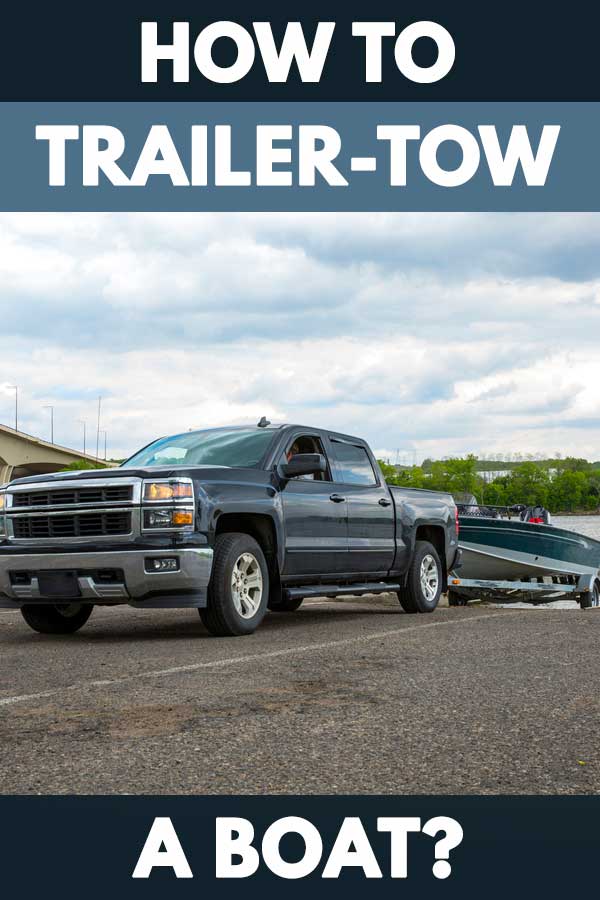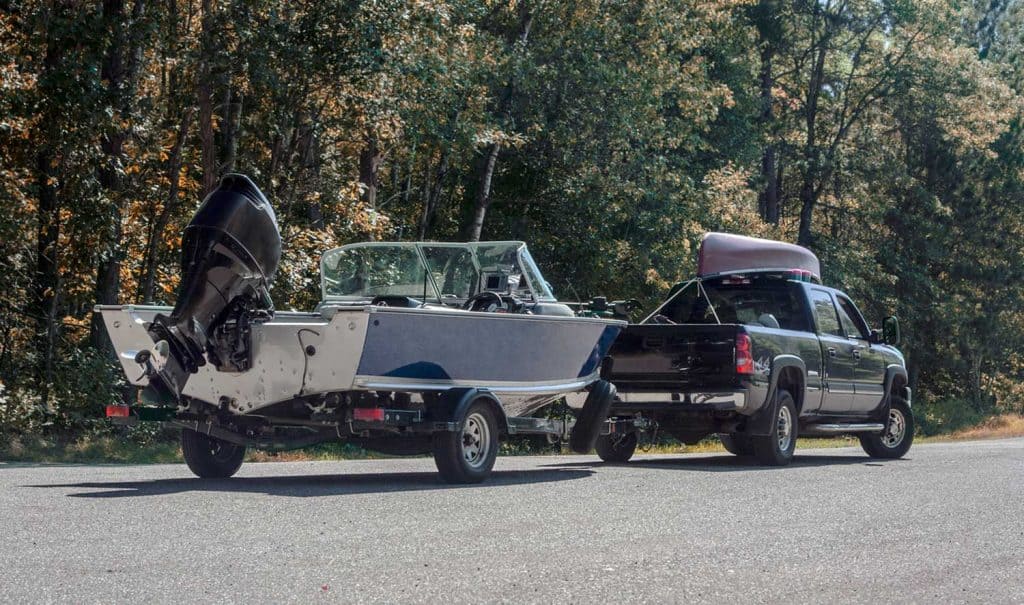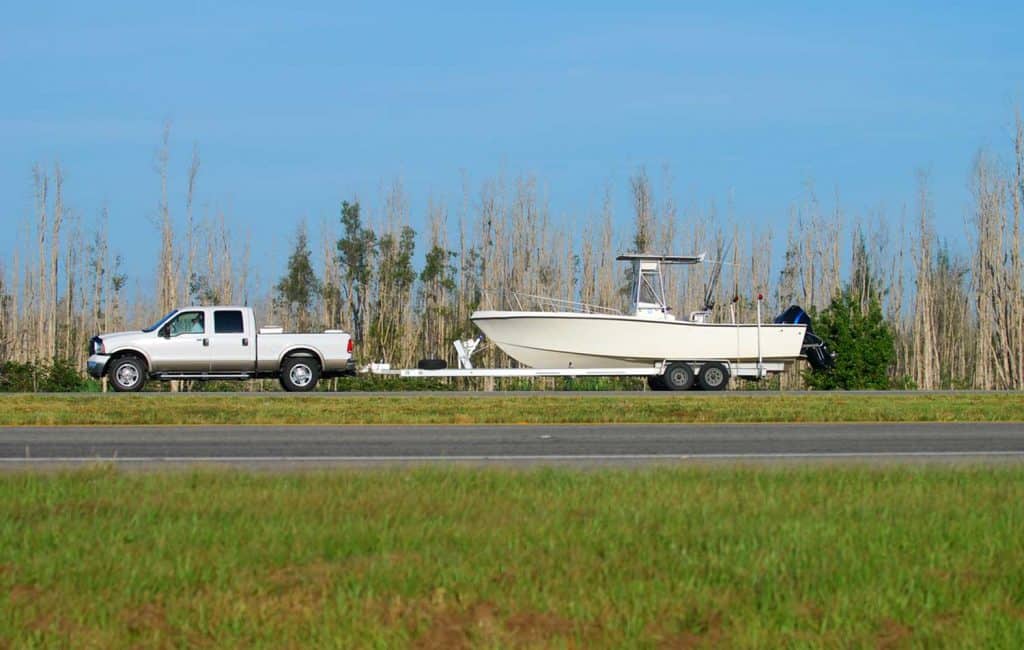 Welcome aboard as a trailered boat owner! The first step toward maximizing your time on the water is to tow your trailered boat. As a fellow boat owner, I have done some research on how to safely tow a boat. A few basic tips can get you underway with the right tow package.
Welcome aboard as a trailered boat owner! The first step toward maximizing your time on the water is to tow your trailered boat. As a fellow boat owner, I have done some research on how to safely tow a boat. A few basic tips can get you underway with the right tow package.
To tow a trailered boat, you must determine the actual weight of your loaded boat and trailer. The weight of the load will answer how much towing capacity is required. After selecting the best tow vehicle, hitch up your trailer and do a safety check. Make sure:
- The hitch is firmly latched with the safety pin in place.
- Cables and chains are firmly secured and crisscrossed; in the event that the hitch fails, crisscrossed cables and chains will support the trailer tongue.
- The winch strap and safety chain are securely fastened to the boat.
- Secure any items aboard the boat that could be blown out such as life jackets, coolers, etc.
- Evenly distribute weight aboard the boat; heavy gear should be stowed over the trailer axles.
- Verify that all brake lights and signal lights work properly.
- Side-view mirrors are adjusted with your trailer in view.
A few practice laps in an empty parking will give you the feel of towing a heavy load. Your vehicle will accelerate and decelerate more slowly. Maneuvering the trailer will require wide turns and active awareness of your blind spots.
Before you hit the road, continue reading to learn how to determine your load weight, towing capacity, and best tow vehicles to get you and your boat safely to the water.
How Heavy are a Boat and Trailer?
Trailered boats vary in weight on average from 850 pound PWC’s to 12,000-pound cabin cruisers. Most importantly, know the combined weight of your boat and trailer. If you want to be absolutely certain, weigh your boat and trailer on a commercial scale. Local landscaping centers or waste centers typically have commercial scales available for your use.
Determining Boat Weight: Dry vs Wet
Every type of boat has dry weight and wet weight. We are not talking about buoyancy, this is the boat’s weight out of the water.
Dry weight is the lightest a boat will ever weigh. Think about a brand-new boat straight from the manufacturer with all the standard features, but no additional accessories. Dry weight is the boat’s actual weight after production. Boat manufacturers can provide dry weights for various models.
Wet weight includes all accessories boat owners add to our boats after production, including passengers. Think about the gear you bring on your weekend trips such as coolers, ice, food, water, fuel, and fishing or ski equipment. Each non-standard accessory adds weight to the boat. Wet weight is a fully loaded boat.
Ultimately, determine your boat’s actual weight by adding your estimated wet weight to the manufacturer’s dry weight.
Determining Trailer Weight: Carrying Capacity Matters

You will want to determine the Gross Trailer Weight (GTW). The GTW is the manufacturer’s weight of the unloaded trailer plus the weight of cargo. In this case, the cargo is your boat.
A loaded trailer should not exceed its Gross Vehicle Weight Rating (GVWR). Gross Vehicle Weight Rating (GVWR) is the maximum allowed, loaded weight a vehicle can safely carry as determined by the manufacturer.
How do you find the GVWR? First, locate the capacity plate on your trailer. The capacity plate lists the trailer’s Gross Axle Weight Rating (GAWR). GAWR is the maximum amount of weight an axle can support, given appropriate tire size and pressure. If your trailer only has one axle the GAWR and the GVWR will be the same.
Boat U.S. provides a simple equation to find GVWR. If the trailer has only one axle the GVWR is conveniently listed on the capacity plate. If the trailer has multiple axles, multiply the GAWR by the number of axles to determine the GVWR. Does your boat weigh more than the trailer’s GVWR? If the answer is yes, consider a trailer with a higher carrying capacity to safely tow your boat.
How Much Towing Capacity do I Need?
It is always better to have extra towing capacity for the sake of the tow vehicle’s performance and your safety if put into a strenuous situation.
Vehicle Towing Capacity
Manufactures provide towing capacity in the owner's manual. You can also find towing capacity in online databases such as Axle Advisor. Look for a vehicle with a towing capacity that is equivalent to or higher than the combined weight of your boat and trailer. Too little towing capacity can put undue strain on the vehicle’s suspension and transmission, potentially leading to equipment failure or an accident.
Also consider:
- Tongue Weight: The weight the trailer bears down on the hitch should be about 10% of the combined weight of the boat and trailer. The tow vehicle can lose traction or be difficult to maneuver with too much tongue weight. The trailer can swing uncontrollably with too little tongue weight.
- Gross Combined Weight Rating (GCWR): It’s probable your tow vehicle will be loaded with gear and passengers, just like your boat. GCWR is the vehicle’s maximum weight capacity including cargo plus GTW. The GCWR lets you know your tow vehicle is capable to tow when fully loaded.
- 2-Wheel, 4-Wheel, or All-Wheel Drive: Two-wheel drive vehicles provide the highest towing capacities. Four-wheel drive vehicles provide the most low-end torque power, which can be helpful if you plan to launch and haul your boat from steep, slippery boat ramps. All-wheel drive vehicles provide the best traction performance, at the expense of torque power.
Hitch Towing Capacity
A capable hitch has an appropriately sized ball mount to couple to your trailer and the towing capacity to carry your load.
Standard hitch receiver sizes are 1 ¼”, 2”, 2 ½”, and 3”. Different size ball mounts can easily be interchanged using a hitch receiver.
Each hitch has its own towing capacity, distributed among five class ratings:
- Class I: 2,000 pounds or fewer
- Class II: 3,500 pounds or fewer
- Class III Weight Carrying: 8,000 pounds or fewer
- Class III Weight Distributing: 10,000 pounds or fewer
- Class IV Weight Carrying: greater than 10,000 pounds
- Class V-XD: 16,000 to 17,000 pounds
- Class V-CD: 18,000 to 20,000 pounds
Hitches are designed to either carry or distribute the trailer’s tongue weight. Class I and Class II hitches carry weight on the ball mount, weighing down the rear axle of the vehicle. Class IV and Class V hitches use additional hardware to distribute weight between the front and rear axles of the vehicle, keeping the vehicle and trailer level. Class III hitches are most versatile as they can carry weight or be combined with additional hardware to distribute weight.
What is the best truck for towing a boat?

Trucks undoubtedly make the cut for towing capacity, driver comfort, and versatility. U.S. News & World Report rates the top trucks for towing in 2019.
Mid-Size Trucks
The Honda Ridgeline is equipped for towing Class II loads with a towing capacity of 5,000 pounds. Upwards to Class III loads, mid-size trucks such as the Nisson Frontier, Toyota Tacoma, GMC Canyon, and Chevrolet Colorado are equipped for towing 6,000 to 7,700 pounds.
Full-Size Trucks
The Nisson Titan and Toyota Tundra weigh in on the low end of towing capacity for full-size trucks, capable of towing Class III loads. With towing capacity upwards of 12,000 pounds the Chevrolet Silverado, GMC Sierra 1500, and Dodge Ram 1500 can haul the load. The Ford F-150 has the highest towing capacity of U.S. News & World Report’s 2019 rated best towing trucks. At a towing capacity of 13,200 pounds, Ford F-150 can haul Class IV loads.
Trailered Boat Tow Package
As you can see, how to tow a trailered boat is largely determined by load weight and towing capacity. With the right tow package, you will soon get the hang of towing a boat underway to your next watery destination.
